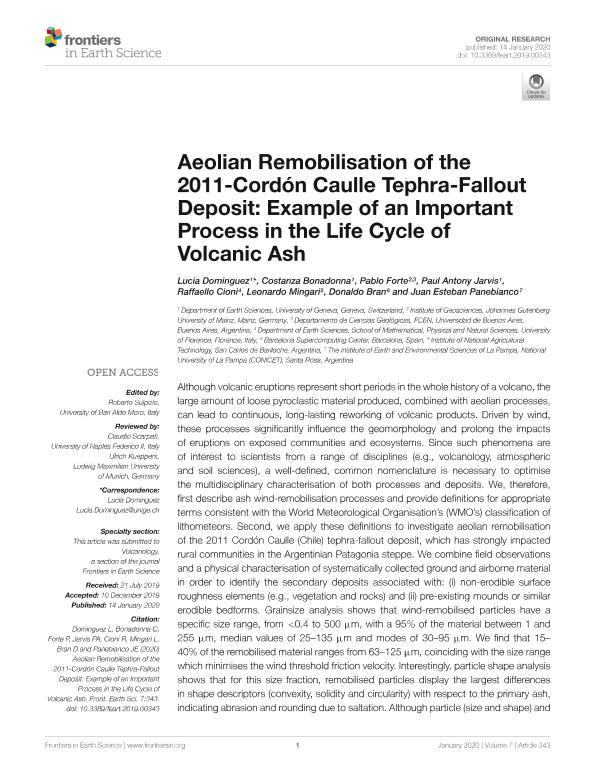Artículo
Aeolian Remobilisation of the 2011-Cordón Caulle Tephra-Fallout Deposit: Example of an Important Process in the Life Cycle of Volcanic Ash
Dominguez, Lucia; Bonadonna, Costanza; Forte, Pablo Brian ; Jarvis, Paul Antony; Cioni, Raffaello; Mingari, Leonardo Alejandro
; Jarvis, Paul Antony; Cioni, Raffaello; Mingari, Leonardo Alejandro ; Bran, Donaldo Mauricio
; Bran, Donaldo Mauricio ; Panebianco, Juan Esteban
; Panebianco, Juan Esteban
 ; Jarvis, Paul Antony; Cioni, Raffaello; Mingari, Leonardo Alejandro
; Jarvis, Paul Antony; Cioni, Raffaello; Mingari, Leonardo Alejandro ; Bran, Donaldo Mauricio
; Bran, Donaldo Mauricio ; Panebianco, Juan Esteban
; Panebianco, Juan Esteban
Fecha de publicación:
01/2020
Editorial:
Frontiers Media
Revista:
Frontiers in Earth Science
ISSN:
2296-6463
Idioma:
Inglés
Tipo de recurso:
Artículo publicado
Clasificación temática:
Resumen
Although volcanic eruptions represent short periods in the whole history of a volcano, the large amount of loose pyroclastic material produced, combined with aeolian processes, can lead to continuous, long-lasting reworking of volcanic products. Driven by wind, these processes significantly influence the geomorphology and prolong the impacts of eruptions on exposed communities and ecosystems. Since such phenomena are of interest to scientists from a range of disciplines (e.g., volcanology, atmospheric and soil sciences), a well-defined, common nomenclature is necessary to optimise the multidisciplinary characterisation of both processes and deposits. We, therefore, first describe ash wind-remobilisation processes and provide definitions for appropriate terms consistent with the World Meteorological Organisation’s (WMO’s) classification of lithometeors. Second, we apply these definitions to investigate aeolian remobilisation of the 2011 Cordón Caulle (Chile) tephra-fallout deposit, which has strongly impacted rural communities in the Argentinian Patagonia steppe. We combine field observations and a physical characterisation of systematically collected ground and airborne material in order to identify the secondary deposits associated with: (i) non-erodible surface roughness elements (e.g., vegetation and rocks) and (ii) pre-existing mounds or similar erodible bedforms. Grainsize analysis shows that wind-remobilised particles have a specific size range, from <0.4 to 500 μm, with a 95% of the material between 1 and 255 μm, median values of 25–135 μm and modes of 30–95 μm. We find that 15–40% of the remobilised material ranges from 63–125 μm, coinciding with the size range which minimises the wind threshold friction velocity. Interestingly, particle shape analysis shows that for this size fraction, remobilised particles display the largest differences in shape descriptors (convexity, solidity and circularity) with respect to the primary ash, indicating abrasion and rounding due to saltation. Although particle (size and shape) and deposit features (morphology and structures) alone are insufficient to interpret transport mechanisms, their combination suggests that whilst saltation is the most common particle transport mechanism, suspension and creep also play an important role. As well as inferring transport mechanisms from this combined approach, we also demonstrate how the correlation of the primary volcanic source with the associated remobilised deposits is fundamental to our understanding of the life cycle of volcanic ash.
Archivos asociados
Licencia
Identificadores
Colecciones
Articulos(INCITAP)
Articulos de INST.D/CS D/L/TIERRA Y AMBIENTALES D/L/PAMPA
Articulos de INST.D/CS D/L/TIERRA Y AMBIENTALES D/L/PAMPA
Citación
Dominguez, Lucia; Bonadonna, Costanza; Forte, Pablo Brian; Jarvis, Paul Antony; Cioni, Raffaello; et al.; Aeolian Remobilisation of the 2011-Cordón Caulle Tephra-Fallout Deposit: Example of an Important Process in the Life Cycle of Volcanic Ash; Frontiers Media; Frontiers in Earth Science; 7; 1-2020; 1-20
Compartir
Altmétricas



